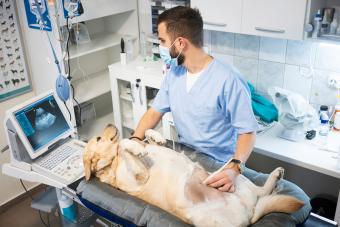
Like humans, dogs can develop cysts on their ovaries. Although ovarian tumors in dogs are uncommon, they do emerge, particularly in English Bulldogs, German Shepherds, and Yorkshire Terriers. These tumors, or cysts, can be cancerous or non-cancerous, but without testing, you won't be able to tell.
Types of Ovarian Cysts and Tumors
Ovarian tumors are benign (non-cancerous) or malignant (cancerous) growths that arise from the excessive, disorganized development of cells within the ovary. Ovarian carcinomas (cancerous tumors) are the most prevalent type of ovarian tumor or cyst in dogs. Ovarian cancers in dogs are divided into three categories:
Epithelium
Epithelial cell tumors (skin/tissue) alone account for 40 to 50 percent of all ovarian malignancies in dogs. Papillary adenomas, papillary adenocarcinomas, cystadenomas, and undifferentiated carcinomas are tumors that arise from epithelial cells.
Germ
Germ cell tumors (ova) account for 6 to 12 percent of all ovarian neoplasms in dogs. Dysgerminomas, teratomas, and teratocarcinomas have been classified based on their original origin.
Connective tissue
These types of tumors, also known as stromal tumors, make up nearly half of all ovarian malignancies in dogs. They are solid and frequently contain numerous cysts. These tumors typically develop to be rather large and have a 20 percent chance of spreading. Sublumbar lymph nodes, liver, pancreas, and lungs are all common metastatic locations.

Signs and Symptoms
Unless the tumors become obviously large, there are usually no signs indicating their presence. Tumors are identified by hormonal disruption and fluid in the abdomen. Stromal-type, or connective tissue, tumors are most likely to become larger than other types. Aside from an enlarged abdomen, symptoms may include:
- Failure to enter heat
- Red discharge from vulva
- Enlarged vulva
- Loss of fur
- Discomfort when touched
- Continuous menstruation
- Excessive testosterone production
Cause of Ovarian Tumors
Although ovarian cancer is not common in dogs, it does affect them more frequently as they become older, especially if they haven't been spayed. Early detection of signs may help prevent malignant tumors from spreading throughout the body. Unfortunately, not all tumors are visible simply by looking at the dog. Breeds most prone to ovarian cyst or tumor development include German Shepherds, Boxer Dogs, Yorkshire Terriers, Poodles, Pointers, and Boston Terriers.
According to Dr. Demian Dressler, the "Dog Cancer Vet" and author of The Dog Cancer Survival Guide, "Some dogs are born with genetic mutations passed on from their parents' DNA, which can develop into cancer later. To the guardian, that cancer may seem to pop up overnight, when, in fact, it developed over the genetic history of the dog." Although there may be external factors, it's possible certain dogs are already at a higher risk than others of developing cysts or tumors.
Diagnosing Ovarian Tumors
If you suspect something is off, regardless of the cause, you should make an appointment with your veterinarian. If your veterinarian suspects any type of tumor, they will recommend a series of tests. Initially, these tumors can be difficult to detect, but they can be discovered by a physical exam or normal bloodwork. Your veterinarian may palpate (feel) a significant mass in the belly, see certain external indications, such as a large vulva or vaginal discharge, and look for abnormalities in bloodwork during a physical examination.

If an ovarian mass is suspected, additional tests may be recommended, including:
- X-rays: To determine if there is a mass on the ovaries
- Fine-Needle Aspiration: Biopsy to determine if there are cancerous cells
- Thoracic Radiograph: To determine if cancer cells have spread throughout the body (metastasis)
- Ultrasonography: Determines tumor size
Dr. Dressler emphasizes, "Using simple imaging tests, such as X-rays and ultrasounds during routine exams could make catching cancer earlier possible, just like mammograms do for human breast cancer." Although testing can be costly at times, it's important to permit further examination if your veterinarian believes something is abnormal.
On the other hand, it's also important you trust your veterinarian. If there are trust issues, you're less likely to follow their recommendations. If you need help to find a new veterinarian or would like a second opinion, you can find one using the AVMA directory. If you would like a more holistic approach, a directory of holistic veterinarians is also available.
Treating Ovarian Tumors
The most common and pursued therapeutic option is ovariohysterectomy (spaying). It is the treatment of choice for benign or locally developing cancers because the tumors are entirely eliminated in most cases.
If staging and other diagnostic tests reveal that the cancer has metastasized (spread to other parts of the body), a spay treatment with removal of other afflicted tissues or lymph nodes may still be performed. Chemotherapy may be used as a follow-up, though there is limited evidence of its effectiveness.
After your treatment has been completed, whether the tumor or cyst is benign (non-cancerous) or malignant (cancerous), you should schedule follow-up appointments with your veterinarian every three months so they can check for new or continuing growth (metastasis).
Consider Spaying for Prevention
Given that the majority of pet owners in North America spay their dogs, these tumors are quite rare. Breeding dogs exposed to fluctuating sex hormones for an extended period of time, with recurrent estrus cycles and pregnancies, may be more prone to developing malignant tumors. Many of these malignancies can be treated, however spaying is usually required.







